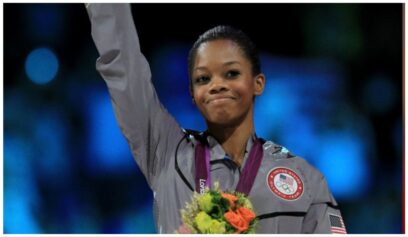When discussing the fastest living humans of all time, there aren’t many candidates. Where track differs from other sports is that theres no grey area or endless debate about who reigns supreme. The answer lies in the numbers and the hardware.
And when we break down the fastest women in the history of the modern world, Carmelita Jeter stands a shameless second to the legendary and culturally-iconic Florence Griffith-Joyner (RIP) who holds down the Top 3 spots for the fastest 100m times ever run by a woman in competition.
Flo Jos long nails, edgy sex appeal, uniquely-crafted running suits and some mythical 1988 performances in Indiana (Olympic Trials) and Seoul, Korea set the standard for ultimate dominance and speed in women’s track & field. A level of magnificence that only Jeter has come close too. Flo Jo has since passed on and ascended to mythical status. Shes an American treasure, but her final gun has sounded.
However, the 35-year-old Jeter, undisputably recognized as the fastest woman in the world is still here ripping up the track, giving younger girls the business and chasing Olympic gold.
Her Olympic star was never brighter than at the London Games in 2012. Carmelita won a gold by anchoring the US Olympic 4x100m record-smashing relay team. She also joined Flo Jo as the only athletes to ever medal in both the 100m and 200m race at an Olympic Games, taking home a Silver in the 100m and a Bronze in the 200m.
She holds three of the top 10 fastest 100m times ever run in competition and shes always a threat to win an IAAF World Championship. Unfortunately Jeter will miss this years faceoff, scheduled to begin on August 22 in Beijing, China, as she rehabs an injury and prepares for the 2016 Summer Olympics in Rio de Janeiro, Brazil. She did, however, find time to speak with The Shadow League about her career, her lifestyle, her future endeavors and being the fastest woman alive.
Carmelita Jeter: To be honest, sometimes I forget that I hold that distinction. In 2009 I did run 10.64 and sometimes people have to remind me of that. I have to remind myself. It definitely feels good to be reminded of something I did and worked really hard for.
Jeter, a beautiful, supremely-conditioned and disciplined woman is often asked for her anti-aging secrets. She says theres no special recipe. Just years of hard work.
Carmelita Jeter: Being organized and consistent is the key to my longevity and continued success. I just have everything in my life structured really well and thats just something that starts with training. Im at the weight room at a certain time. Im having practice at a certain time. I write everything down before I go to sleep, so Im very structured in how everything needs to be the next day.
That keeps me grounded and settled with things I need to do. I go to bed early and wake up early so those are the things that keep me structured with training so I’m able to run the amount of years that Im running. You have to eat well and sleep well. You have to live a certain way and Im not so sure its a secret because theres a lot of other people doing it as well.
I grew to be very structured. My Mom and Dad had a lot to do with it. As a kid, you could go outside when it was early, but when those streetlights came on you knew it was time to go home. So I definitely knew growing up that I had to leave the house and be in the house at a certain time. On Friday me and my younger brother would have to clean up the house and wash our clothes before we would go outside. So I do believe my structure began as a child and I held onto it as I got older. I stayed washing my clothes and cleaning up every Friday even though I didnt live in the household with my parents anymore.
Going outside consisted of playing basketball. I grew up in a basketball household. We all played ball and we had a court in the front yard and our house was the house everyone came to and on Saturdays we would basically have tournaments in front of the house. Those mini-tournaments helped my little brother Eugene Pooh Jeter make it all the way to the NBAs Sacramento Kings and he played in the 2010-2011 season. I really think it was just a way that my dad could keep an eye on us and keep us out of trouble… where he could see us. Everybody would just be at our house playing basketball.
My freshman year in high school my basketball coach suggested that I run track in the offseason to stay in shape. I say, Ok. I go out for the track team and I turned out to be really good. I ran an 11.7 that first season and decided to stick with track because it was my sport. I didnt have to share it with my brothers or share time with my dad. It was just me and his time. That’s probably the number one reason why I stayed running track because my dad would come to my track meet and I didnt have to share that with anyone. Then I really started to like it and love it. Then I was like, OK, this truly is my sport. It was such an individual sport. If I won, I won. If I lost, I lost. So I loved track a little more than basketball.
Fast forward to 2015 and I turned a special talent into a career that has taken me all over the world and on adventures that you couldnt make up in a movie. To be recognized among the legends of the sport like Flo Jo and Marion Jones and the like, feels good and shows the hard work Ive put in over the years because you know sometimes people think I just fell out of the sky and became fast and it doesnt work that way. I had to lose before I could win the big ones.
I had to pay my dues. I went to Bishop Montgomery HS and ran track there for four years, then I went on and got a track scholarship to California State University, Dominguez Hills which is located in Carson, California. I graduated with a degree in Kinesiology.
In college, Jeter set the record for most NCAA medals by a California State University, Dominguez Hills track athlete and became the University’s first U.S. Olympic Trials qualifier.
Carmelita Jeter: But it took years for me to get fast. A recurring hamstring problem kept me from competing for most of 200305. In 2007 I finally went pro. So that wasnt overnight. I was building up to be a great runner and it finally happened in 2009. It was great doing something that I always knew I was capable of. I always knew I was capable of running very fast. When I made the switch in 2008 to John Smith, who formerly coached Olympic champion Maurice Greene, it was all about getting with the right coach and getting into the right situation with the right people on the track. Everything was perfect and it just shows how hard I worked to get there. Sometimes people don’t see all of the steps it took to get to 2009 and thats what I appreciate more than anything — the steps it took to get to 2009. They only see the time and see that I ran fast.
Carmelita Jeter: You can’t please everybody. There’s always going to be someone who has something to say about what you should be doing. Unfortunately in sports you cant say; Im going to get this medal or Im going to do this or that… because when you line up anything goes. Just like in basketball, whoever thought that the Warriors would win the NBA Championship? It is what it is at times. Sometimes someone can have the race of their life and end up winning and you’re trying to figure out what happened that day. Its just a part of life. You get 10 seconds to get it done and sometimes you get it done right and sometimes you come up short. Its just a part of the sport.
Carmelita lost her aunt to breast cancer shortly before the London Games and embraced that sorrow and inspiration by winning three medals.
Carmelita Jeter: Her name was Brenda Washington and she passed away in March of 2012. She meant everything to me. Just to put things in perspective, I brought my first house down the street from her. That lets you know right there the extent of our relationship. Nobody would think to do that, but I did so that shows how much she meant to me. It was hard and rough preparing for the 2012 Olympics. They tell you how to smile and how to give the right answers to the media, but nobody tells you how to deal with the loss of an aunt, something thats so traumatic. That was the hardest part of my career, dealing with the loss of my aunt and still having to be a professional athlete and having to show up to do certain things and still be Carmelita Jeter at a time when I didnt want to be Carmelita Jeter.
I know my aunt wanted me to make that team, so that was my goal. I had a bad hamstring going into the Olympic Trials. I made the 100m team and my coach said, No, youre not running the 200, but I said, Yes I am. For my aunt Im making this team.
If you watch the tape, I limped from 100 meters to the finish line and took second in the 200m at The Olympic Trials. So that right there lets you know how much this woman means to me. It felt really good walking into Olympic Stadium. I cried the whole time because I really wish she could have been there, but I flew her daughter (my cousin) Lashanda Washington to the Olympic Games so that she could be a part of it.
The impact of her aunts death inspired Carmelita to new heights on and off the track. According to Jeter’s bio on CarmelitaJeter.com, she made it her mission to help fight for a cure for cancer. She partnered with Nike to design hot pink spikes that she wears during each race in support of Breast Cancer research. In 2014, Carmelita was named the official Ambassador for Susan G. Komens California Circle of Promise Initiative designed to promote breast cancer awareness among African American women.
In 2014, Carmelita launched her first Track Clinic. The Team Jet Track Clinic attracted over 100 kids who learned about health and fitness while also polishing up their track skills.
Carmelita Jeter: My indoor season didnt allow me to do the clinic this year, but I will be starting it back up again next season. It took a lot of my time. I enjoy doing my clinic. I love seeing the kids out there running around and everybody was trying to be Jet for a day. It was great and it always felt good to do something that even though it’s so small, it’s so big to someone else.
I was a bit down-and-out because I tore my left quad at US Trials so I wont be representing in the Beijing World Championships in August. I spent some time with the Special Olympics not too long ago, which gave me some great perspective. Theres other people that have worse problems than you or I do and they are making everyday the best it can be. Sometimes you have to step back and check yourself.
I appreciate what I am capable of doing and a minor setback isnt going to dampen my spirits or stop my enthusiasm for watching the rising stars of this game ascend in my absence. The future of womens track is bright. We have a lot of young women coming up and I give them two or three more years and they are going to take over track & field. I’m excited to see what they do in a couple of years. Its a learning process…a baby step process. I came in 2007 and didn’t really blossom until about 2010. I’m excited for the new squad coming around 2018.
As one of the game’s ambassadors, Jeter is plotting her next move but staying true to the game and handling her setbacks with class.
Carmelita Jeter: Im a competitor. Ill compete with one toe or one leg. I just love competing. It’s in my soul. It’s definitely not fun right now watching the track meets on TV, but I will cheer for Team USA and want them to get it done. I will be cheering my heart out and watching that. Right now, just to get Carmelita back, Im doing a lot of bike riding on the stationary bike every day. That’s not fun, but it’s definitely a start and a part of what I have to do. I’m seeing a doctor at least three days a week to make sure everything is good, so I’m going in the right direction and trying not to be sad about it. I will be gearing up for Rio and that’s where my mind set is. It’s all about Rio 2016.



